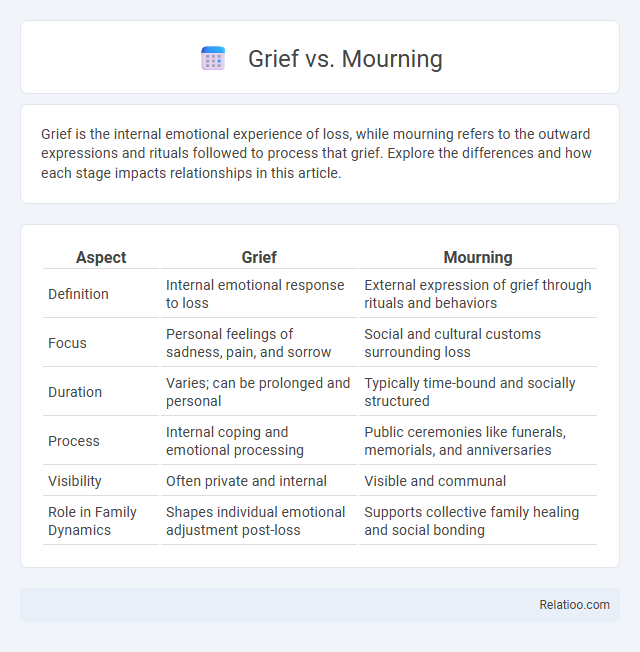Grief is the internal emotional experience of loss, while mourning refers to the outward expressions and rituals followed to process that grief. Explore the differences and how each stage impacts relationships in this article.
Table of Comparison
| Aspect | Grief | Mourning |
|---|---|---|
| Definition | Internal emotional response to loss | External expression of grief through rituals and behaviors |
| Focus | Personal feelings of sadness, pain, and sorrow | Social and cultural customs surrounding loss |
| Duration | Varies; can be prolonged and personal | Typically time-bound and socially structured |
| Process | Internal coping and emotional processing | Public ceremonies like funerals, memorials, and anniversaries |
| Visibility | Often private and internal | Visible and communal |
| Role in Family Dynamics | Shapes individual emotional adjustment post-loss | Supports collective family healing and social bonding |
Understanding Grief and Mourning: Key Differences
Grief is the internal emotional response to loss, characterized by feelings such as sadness, anger, and confusion, while mourning refers to the external, cultural, and social practices individuals engage in to express and process that grief. Understanding these distinctions is crucial for recognizing that grief is a personal, psychological experience and mourning involves rituals like funerals, memorials, or specific traditions. Effective support for those experiencing loss involves acknowledging both the emotional turmoil of grief and the cultural context of mourning practices.
The Emotional Landscape of Grief
Grief represents the deep emotional response to loss, encompassing feelings of sadness, anger, and confusion that arise internally. Mourning refers to the outward expression of grief through rituals, social customs, and personal behaviors that help you navigate the emotional pain. Understanding the emotional landscape of grief allows your healing process to unfold naturally, blending both personal sorrow and societal support.
Mourning: Cultural and Social Expressions
Mourning involves culturally specific rituals and social behaviors that help individuals process grief while honoring the deceased. These expressions vary widely, including practices such as wearing specific clothing, participating in memorial services, and following religious customs that provide communal support and meaning during loss. Understanding your own cultural mourning practices can offer comfort and guidance as you navigate the emotional complexities of bereavement.
Psychological Impact: Grief Versus Mourning
Grief represents the internal emotional response to loss, characterized by intense sadness, anxiety, and psychological distress, while mourning encompasses the external expressions and rituals that help process these emotions socially and culturally. Your psychological well-being is influenced by both experiences, as grief triggers profound cognitive and emotional challenges, and mourning provides structured mechanisms for coping and healing. Understanding the distinction between grief as an internal pain and mourning as a social process is essential for effective mental health support and recovery.
Grief Stages: Personal Journeys Through Loss
Grief encompasses a complex emotional response to loss, marked by personal journeys through stages such as denial, anger, bargaining, depression, and acceptance, as defined in the Kubler-Ross model. Mourning represents the outward expression of grief, often influenced by cultural rituals and social customs that provide structure to the healing process. Differentiating grief and mourning is crucial for understanding individual coping mechanisms and the diverse ways people navigate loss.
Mourning Rituals Across Cultures
Mourning rituals vary widely across cultures, reflecting diverse beliefs and practices surrounding death and the afterlife. In many societies, these rituals involve specific ceremonies, dress codes, and periods of silence or reflection to honor the deceased and provide communal support. Understanding Your cultural context helps navigate these customs respectfully while processing grief effectively.
Common Myths About Grief and Mourning
Grief, mourning, and bereavement are often misunderstood, with common myths confusing their distinct processes: grief is the internal emotional response to loss, mourning is the external expression of that grief, and bereavement refers to the state of having lost someone. You might believe that grief follows a linear path or that mourning has a set time frame, but in reality, these experiences vary greatly among individuals. Understanding that grief and mourning do not adhere to prescribed rules allows for a more compassionate and personalized approach to healing.
Supporting Someone in Grief vs. Mourning
Supporting someone in grief requires empathetic listening and acknowledging their individual emotional experience, as grief encompasses the internal response to loss, including sadness, anger, and confusion. Mourning, the external expression of grief through rituals and cultural practices, benefits from offering practical assistance, such as helping with memorial arrangements or providing a comforting presence during ceremonies. Understanding these distinctions enables tailored support that respects both the personal emotional journey and the social customs that aid healing.
Healthy Coping Strategies for Grief and Mourning
Healthy coping strategies for grief and mourning include openly expressing emotions, seeking social support, and engaging in self-care activities such as exercise and proper nutrition. Grief involves internal emotional responses to loss, while mourning refers to external rituals and expressions honoring the deceased. Implementing therapeutic techniques like counseling, mindfulness, and journaling can facilitate healing and promote psychological resilience during the adjustment period.
When to Seek Help: Complicated Grief and Prolonged Mourning
Complicated grief and prolonged mourning occur when intense sorrow persists beyond the typical healing period, severely impacting daily functioning and emotional well-being. You should seek professional help if feelings of grief remain overwhelming after six months, interfere with relationships, or lead to severe symptoms like hopelessness or suicidal thoughts. Early intervention from mental health experts can provide tailored support and effective coping strategies during these challenging phases.

Infographic: Grief vs Mourning
 relatioo.com
relatioo.com